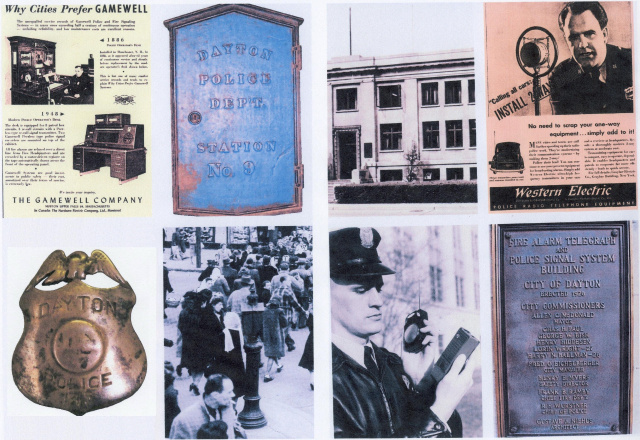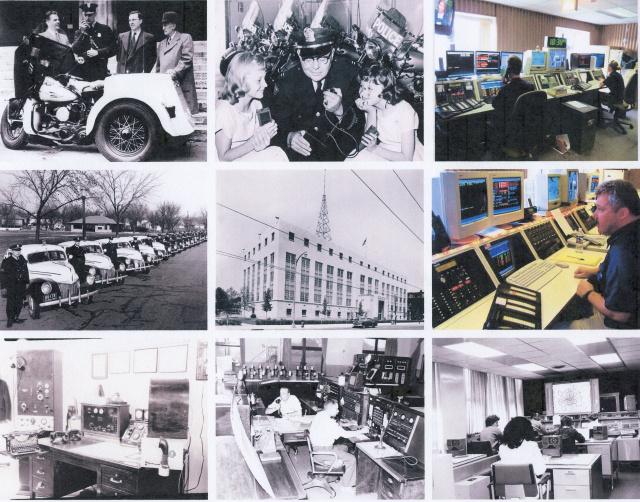100 Years of Dayton Police Patrol Communication Technology
1896 Patrol Call Box to 1995 CAD/MIS: Computer-Aided Dispatching
by Sgt. Stephen C. Grismer (ret)
After the Civil War – during the infancy of organized law enforcement – Dayton police communication methods were limited at best. Patrolmen in need of assistance could summon fellow officers by rapping nightsticks on curbs, blowing whistles, shooting in the air or hollering. Citizens needing the assistance of law enforcement would have to seek out a police officer walking the beat or go directly to the police station on E. Sixth Street at Tecumseh Ave.
The broad introduction of telephones to the Dayton community in 1883 changed local policing forever. Citizens were able to telephone police headquarters and a “roundsman” could track a patrolman to answer the call for service. In 1896, the city of Dayton purchased the Gamewell system of communications and strategically placed 64 police patrol call boxes throughout the city. This gave foot patrolmen the means to communicate with a “central exchange” by both telegraph signal and telephone. Officers could call for personal assistance at anytime and were required check in every half hour to be dispatched to trouble calls on their beat.
In 1901, a red light signal system was installed at 12 “stations” throughout the city. If the red light illuminated, officers had to immediately go to the closest call box and telephone the central exchange. Patrol call boxes were used by walking officers for nearly 70 years into the 1960s.
In 1928 Detroit became the first city to equip its patrol cars with one-way radio communication. That same year, the city of Dayton dedicated its newly-constructed Police-Fire Signal Building at 15 E. Monument. The “central exchange” would eventually become known as the dispatch center. In 1932, Dayton also equipped its police fleet with one-way radios. The police operator (dispatcher) not only monitored ticket tape machines and telephone calls, but would also transmit information to police patrol cars from a desk by way of a Western Electric dispatch microphone. The information might be to call in from a call box, to return to the station house or to receive a “BOLO” (i.e. “be on the lookout”).

In August 1939, Motorola introduced the first practical and cost-efficient radio transmitter for installation in patrol cars. The two-way police radio system emerged. In 1940, Dayton became the first police department in the nation to install two-way radios in its fleet of police cruisers (WPDM). This was done in preparation for the visit of President Franklin Roosevelt to Dayton in August 1940 [a photo of the Dayton police patrol fleet is framed at the Motorola corporate offices in Chicago]. By 1947, Motorola two-way radios were installed on Dayton police motorcycles and servi-cars (i.e. three-wheel cycles).
In 1956, the police dispatch center moved from the Signal Building to the newly-constructed Safety Building at 335 W. Third Street. This would remain the Dayton police dispatch center for the next 30 years and serve for the introduction of hand-held portable radios. In 1962, Motorola one-way portable radios were placed into service, vastly improving communications for foot patrolmen. In 1964, two-way portable radios were issued, allowing foot patrolmen to “immediately summon needed equipment or additional personnel to cover any situation.” [Dayton Annual Report 1964]
By the 1970s, portable 150 MHz high-band police radios were being issued to officers in police cruisers. The next evolution of the portable radio was the Motorola 450 MHz hand-held model and by the mid-1970's, all uniformed officers, without exception, were equipped with four-channel Motorola radios with corded microphones.
In 1984, the police department undertook the most innovative, costly and successful venture in its history... and did so in cooperation with NCR. The effort led to the police and fire returning their dispatching operations to the Signal Building to become the cutting-edge model of dispatch technology nationwide. NCR made major computer-based applications a local reality and the preeminent system in the United States. Those systems included computer-assisted dispatch (CAD), management information systems (MIS), mobile cruiser data units (KDT/MDT), 9-1-1 emergency system and centralized integrated dispatching of police and fire.

The nation’s leading computer assisted technology began with a crucial first step when Virginia Kettering allowed the placement of an antenna on top of the 505 foot Kettering Tower to feed to 7-site microwave rings for a 20-channel 800 MHz system. This infrastructure element, which she authorized for the good of the community, was absolutely essential for the development of what would be the best public safety radio system nationwide.
Motorolaand Dataradio produced the first in-cruiser keyboard date terminals (KDT) and, in1986, the Dayton Police Department became the firstin the country to acquire 16K KDT units. These in-car units had four times the memory and computer power of other existing units. In 1987, after a system investment of a incredible $12 million, dispatching operations returned to the Signal Building on E. Monument. NCR developed the application data systems necessary to create a communications center with technology that seemed to rival that found in the Star Wars movies of the time.
In 1988 when the first generation Motorola KDT 480 went on-line with the Signal Building, the Dayton Police Department became the first police force in the nation to run at 100% signal efficiency… in other words, no missed calls. No other police agency believed 100% efficiency could be achieved. At the time, 92% efficiency was considered an extraordinary level. Dayton also developed the first high speed data network... a technology analogous to having cable service when all others in the country had dial-up. According to the Lt. Barry Bales (ret), the Dayton police point man for this innovative computer dispatch technology, Motorola liked to compare Dayton PD to San Francisco PD in that SFPD “had seven times the units but DPD ran ten times more data.”
Dayton's police dispatching and information systems using NCR applications and, in many cases, Motorola components had many more technological “firsts”. NCR used far more computer power than found with any other police department. Most computer systems were delicate and would crash when encountering what today would be minor problems. Dayton developed a totally redundant system mirroring the dispatch activity as it occurred. The mirrored-system took over if the first system crashed, virtually eliminating down time. Termed LCMP (loosely coupled multi processing), it was the first fault-tolerant computer system in any public safety use anywhere in the world.
NCRhad even greater programming influence with the role it served in exclusively developing the MIS for the Dayton Police Department. Management Information Systems are only as good as the screen template design and the templates NCR developed through the 1990s in Dayton are of such quality in application effectiveness, they are continually duplicated by other cities throughout the nation. Dayton’s MIS templates are still used as present-day models for the underpinning of MIS systems being developed for their respective police departments.
Dayton's MIS is still extensively utilized by Dayton police and other area law enforcement agencies although, in a cost-savings measure, its independent history in dispatching operations came to a close in 2010. The city of Dayton contracted with the Montgomery County Sheriff's Office to have its calls for service managed through the Regional Dispatch Center located in Miamisburg. This is controversial development in police circles, given that it has not been embraced by a number of law enforcement agencies in the county to date. But time and community input will determine whether this new chapter in Dayton police communications is on equal footing with its accomplishments of the preceding century.
________________
Sgt. Stephen C. Grismer (ret)© 2011
Significant contributions to this account were made by Dayton Police Lt. Barry Bales (ret) and Sgt. William Hill (ret).